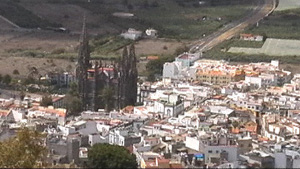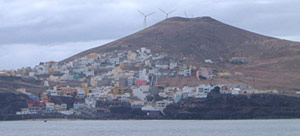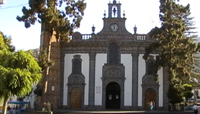TRAVEL
GUIDE
|
Maspalomas
Weather
Gran Canaria Towns
Many people's comments about Puerto Rico and/or Playa
del Ingles include the famous line "It's not very Spanish, is it?"
Puerto Rico is around 30 years old and Playa del Ingles around 40 years
old. Before the resorts appeared, all that exhisted was arid, barren
countryside (and a nice beach in the case of Playa del Ingles). The
resorts were purpose built for tourism.
To see and experience the Canarian way of life or any
Canarian or Spanish traditions, you're going to have to venture out of
the resorts and go and visit any one of a huge number of towns or
villages scattered around the island. Head anywhere other than the
south of the island and you'll find a rich culture of traditions,
festivals, architecture and gastronamy. More typical Canarian towns
well worth a visit...
| AGUIMES
 (population 17,500) San Sebastian Church in
Aguimes houses various works of art including paintings and sculptures
and is one of the most well maintained structures of worship on the
island, having being completed in 1952 (construction began in the late
18th century!), and the designs are based on the Cathedral of Las
Palmas. Located not far from the caves of Guayadeque and adjacent to "Barranco
de Balos". It's at this barranco (valley) that you can find the sacred
Guanche site called "Lomo de los Leteros". The Basalt slope there is
inscribed with pre-hispanic, geometric designs and sketches of human
figures. (population 17,500) San Sebastian Church in
Aguimes houses various works of art including paintings and sculptures
and is one of the most well maintained structures of worship on the
island, having being completed in 1952 (construction began in the late
18th century!), and the designs are based on the Cathedral of Las
Palmas. Located not far from the caves of Guayadeque and adjacent to "Barranco
de Balos". It's at this barranco (valley) that you can find the sacred
Guanche site called "Lomo de los Leteros". The Basalt slope there is
inscribed with pre-hispanic, geometric designs and sketches of human
figures.
More photos of Aguimes
|
|
ARUCAS

(population
30,000) One of the main places of interest in Arucas is the neo gothic
church of San Juan Bautista (St John the Baptist), constructed between
1909 and 1977. Arucas is also the third largest town on Gran Canaria
and has it's own rum distillery worth a visit (and some sampling!) too.
"The Marchess's Garden" is a 10 minute walk from the church, a
botanical garden with a huge collection of both local and tropical
plants. If you get to the top of "Arucas Mountain" (an old volcano),
you'll find a traditional Canarian restaurant up there.
More
about Arucas
|
| ARGUINEGUIN

This is one of the most populated areas along the
south coast of Gran Canaria. A typical Canarian fishing village, it's
home to many locals rather than being a tourist resort. Here you'll
find some excellent bars and restaurants, the latter specialising in
fresh fish caught that day. Tuesday is market day (the largest on the
island). The harbour here hosts a ferry service to Puerto Rico and
Mogán whilst another popular way to reach the town from Puerto
Rico is by trecking over the mountain between the two towns.
|
| AGAETE
 
(population 5,600) Agaete is located in the far, north
west of the island at the foot of the Tamadaba pine woods, also on the
outlet of one of the most beautiful, fertile valleys of the island.
Here they produce lemons, oranges, avocados and coffee whilst Agaete is
more famous through the archipelago for its "Fiesta de la Rama",
celebrated during the first week of August annually. The port of Agaete
is very well known for its fish restaurants, the area being a
fisherman's haven. The port also hosts frequent ferry services to
Tenerife, Lanzarote and Fuerteventura. One of the views from the port
is "Dedo de Dios" (God's finger - pictured above) being a spectacular
rock formation just a few yards out to sea. The area around Agaete is
one of the most richest and fertile areas of the island. As well as
traditional and tropical fruits are grown alongside the coffee
plantations there and the natural mineral water produced in this area
is thought to have medicinal properties!
|
| BANDAMA

It's at Bandama that you'll find the most perfectly
formed crater in the Canary Islands, it has a diameter of 1000m and a
depth of 220m. At the bottom of the crater you will see a farm which
can only be reached by a steep and narrow path and making it (so I'm
told) the only inhabited crater in the world. With views to the
picturesque town of Bandama along with its 18 hole professional golf
course, the oldest in Spain (founded 1891), this is very much an area
worth a visit.
|
| FIRGAS

(population 5,750) Again one of the more picturesque
towns of Gran Canaria I have found, Firgas is famed locally for it's
natural mineral water. Nearby is the "Azuaje Ravine", the waters of
which are believed to have curable properties and many other natural
springs in this area have brought about the construction of the islands
main bottling plant for mineral water.
|
| GALDAR

(population 21,500) Seat of the ancient Guanche rulers
and the first capital of Gran Canaria prior to Las Palmas. The church
of Santiago de Los Caballeros another stop-off point here, known for
its 4700 pipe organ and the green font where, tradition has it, the
Aborigines were baptized. It also houses one of the best collections of
art on the island, both of paintings and sculptures. Also worth a visit
if your in the Galdar is the recently re-opened are the "painted caves", an historical site
of pre-historic caves which are both preserved and restored for display
to the public.
|
| GUIA

(population 12,500) Birth place of the famous painter Lujan Perez, Guia
is better known for the "Casa Quintana", built in the 16th century.
It's also famous for its cheese and Canarian Knives. On the outskirts
of the town you'll find "Cenobio de Valerón", an area of 300 or
so caves once inhabited by the aboriginals. Many of their original
tools, utensils and so on are to be found there on display. Close by is
"EL Gallego", an area of caves where the aboriginals conducted their
funerals.
|
| INGENIO

(population 21,500) "Ingenio de azucar" means sugar
refinery and it was here that a sugar refinery was built when the
Spanish first colonized the island. Ingenio also has a museum to visit
showing how crafts have developed over the centuries. You can see the
"openwork skill" that has been kept alive for centuries and is still to
be displayed here. The "Sequero" district and its buildings date back
to the 15th century. Not to be missed if you're here mid October is
their festival of the billy goat (second Saturday of October) in which
the whole town participates in finding the best goat and parading it
around town all afternoon whilst feasting on huge amounts of food and
drink! Also, close by are the caves of Guayadeque.
|
| TEROR
 
(population 10,500) A very historical town with
buildings dating back to 1692, also a town steeped with religious
history. White houses with grey, exposed stonework and dark, wooden
balconies are the traditional type of architecture to be seen here. On
the 8th of September each year Terror plays host to the "Fiesta del
Pino", the holiday and its atmosphere attracting people from all over
the island, traditionally to pay homage to the Virgin of the Pine, the
Patron Saint of Gran Canaria. Several museums can be found here
dedicated to religion with some remarkable works of art on display. Be
sure to visit the church and if you visit the town on a Sunday you can
enjoy the market day as you stroll around admiring the architecture.
|
| TELDE
 (population 79,000) The second
largest city in Gran Canaria and was once the capital of one of the
Canario Kingdoms. The church of St John the Baptist here is one of the
oldest on the island. Housing a maice-paste statue of Christ weighing
just 5kg along with numerous, valuable works of art, all dating back to
the 15th century. The San Fransisco area of Telde is the oldest yet
best preserved part of the city. Close by, "Montaña de Cuatro
Puertas" (Mountain of four Doors) is a famous archeological sight here,
having unearthed many pre-hispanic and aboriginal relics and on the far
side of this mountain you'll find an aboriginal village of caves. (population 79,000) The second
largest city in Gran Canaria and was once the capital of one of the
Canario Kingdoms. The church of St John the Baptist here is one of the
oldest on the island. Housing a maice-paste statue of Christ weighing
just 5kg along with numerous, valuable works of art, all dating back to
the 15th century. The San Fransisco area of Telde is the oldest yet
best preserved part of the city. Close by, "Montaña de Cuatro
Puertas" (Mountain of four Doors) is a famous archeological sight here,
having unearthed many pre-hispanic and aboriginal relics and on the far
side of this mountain you'll find an aboriginal village of caves.
|
Melenara
Looking for somewhere a bit different to spend the day, maybe combine a
morning of shopping with a traditional Spanish lunch then an afternoon
on the beach? Melenara!
 The
town is located more towards the north of the island, a couple of exits
north of the airport but more useful it's one exit before Al Campo and
5 to 10 minutes drive from Las Terrazas and EL Mirador - these are the
biggest commercial areas in the Canary Islands so of course, the best
shopping you're going to find.
For
shopping there's everything from duty-free electrical from
reliable shops and department stores to clothes, perfumes, alcohol....
well absolutely everything you could want from a day out shopping.
From
there head towards the ocean behind Al Campo and you'll see the sign
for "Melenara".
The
last time I was there I was amazed at how perfect the whole town is, so
well-maintained, so clean and so well designed / laid out. Even the
parked cars were all lined up evenly along the streets, it's so perfect
it's spooky!
 There's
a sea-front promenade from one side of the town to the other which
passes both beaches (Las Salinetas and Playa Melenara). This is a
fishing town and at the far side you'll see where the boats bring in
their catch so if you're stopping off at one of the many restaurants
around the Blue-Flag "Playa Melenara" a fish choice would be
recommended!
The
main beach is huge, dark sand, shaded area at the back thanks to the
trees, blug flag so all the facilities you could need included medical
assistance, lifeguard, toilets, showers, disabled access ...
Don't foget to check the popular RESORTS of Gran
Canaria also:
Puerto
Rico - Playa del Ingles - Maspalomas - Mogan
|
|







